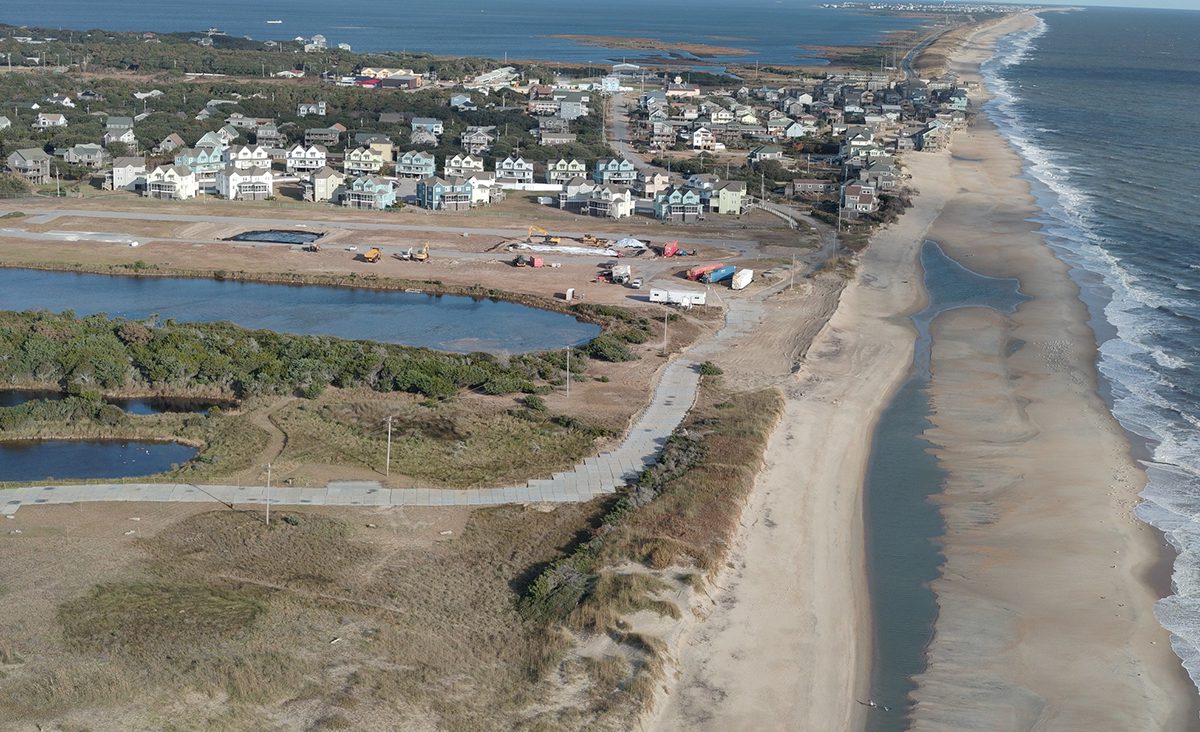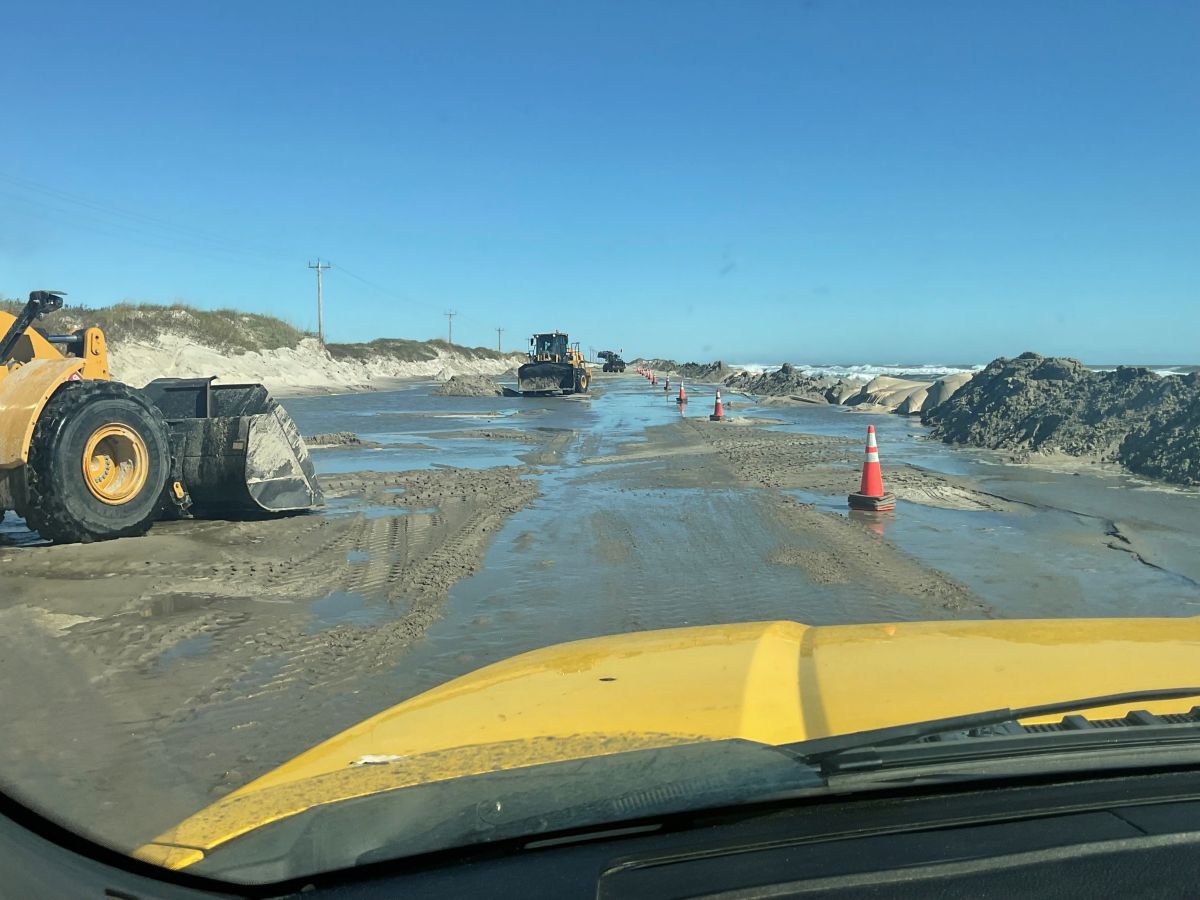
BUXTON — The federal cleanup of Buxton Beach has been remarkable, if only for the stark improvement in its appearance compared with a few months earlier.
With the surface building debris mostly gone, and petroleum-soaked soil removed, now the U.S. Army Corps of Engineers is turning its attention to the long-term well-being of both the site and the community.
Supporter Spotlight
“The dune is clean, the oil is gone from the groundwater, and the beach is clean,” said Brian Harris, co-vice president of the Buxton Civic Association in a recent interview with Coastal Review. Still, he said, a lot remains to be done at the Cape Hatteras National Seashore beach where a secret submarine survey base once operated.
The Coast Guard also operated a base at the site from 1982 until 2010.
“All those buildings that were once there, they’re still there — all the foundations,” he said. “So, it’s great that the beach is clean … but as this thing keeps eroding, I don’t want my son to have to deal with this in 10 years.”
Harris said that he is looking forward to participating in upcoming meetings of the Restoration Advisory Board, or RAB. Within months, the structured group of community and agency members is expected to start meeting regularly to discuss environmental restoration at the Buxton Naval Facility.
“You know, we’ve got everybody at the table now,” he said. “And that’s really what the RAB is going for — to keep this thing going forward, and the plan for the future.”
Supporter Spotlight
Contractor Baywest, a St. Paul, Minnesota-based environmental services company, completed removal of petroleum-contaminated soil and water before Christmas and did a final walk-through with the National Park Service on Jan. 17, according to Corps of Engineers Formerly Used Defense Sites (FUDS) Program Manager Sara Keisler.
The $4.8 million contract will end in June 2025, after Baywest completes beach plantings.
Keisler said another contractor, Yuma, Arizona-based Nicklaus-Ensafe JV, will begin a comprehensive survey of the site in February or early March that will investigate whether more contaminants remain underground.
“Currently, the initial deliverables, which is our work plan and our safety plan, are in the process of being written and reviewed,” Keisler told Coastal Review. “Those will be reviewed by many entities, including the Corps and then we have an independent technical review that has to be done, which is done by our center of expertise.” After several other reviews, the work will be able to start.
The $177,000 contract is scheduled to end in May 2026, she said, but it can be extended if needed.
In 1991, the former Naval base in Buxton, which was a submarine monitoring station from February 1956 until June 1982, was designated as a Formerly Used Defense Site, leaving the responsibility for its cleanup to the Corps. Starting in 1989, the FUDS team removed tons of petroleum infrastructure at the 50-acre site, as well as polluted soil and water, and continued to monitor groundwater. In the last test in 2024, the contaminant levels were below state standards.
But increased beach erosion, exacerbated by rising sea levels and coastal storms in September 2023, exposed chunks of concrete and oily clumps of sand, creating dangerous debris and a strong diesel odor. As a result, the park service closed three-tenths of a mile of Buxton Beach, and a FUDS team returned to the site.
The teams spent month after month investigating the site, and after the September 2024 reoccurrence of petroleum evidence, they developed a response plan, and hired the contractors.
FUDS teams only have the authority to remove petroleum, they’re not allowed to remove underground structures unless they’re in the way.
“While the primary purpose of the ongoing response action is to remove petroleum-impacted soil, some of the remnant infrastructures that impede excavation access to the petroleum-impacted soil have been removed, too,” the Corps’ FUDS team in Savannah District said in a press release. But workers ended up removing considerable amounts of material.
“The team began excavations Oct. 2, 2024, and … they have removed 1,442 cubic yards and 24,126 gallons of petroleum-impacted soil and water, as well as approximately 138,400 pounds of concrete, 1,153 feet of pipes and 1,088 feet of metal cables and wires.”
As of Dec. 11 2024, a total of 4,599 cubic yards of petroleum-impacted soil has been removed; 99,526 gallons of water; 278,000 pounds of concrete; 1,153 feet of pipe; and 1,088 feet of metal cables and wires, according to the Buxton Naval Facility page on the Corps’ website.
Although it took nearly a year after the first report in 2023 for the Corps to start aggressive removal of petroleum contamination, no single source has yet been identified, despite numerous early efforts by the agency.
“From our perspective, the source is previously unremoved contaminated soil and groundwater,” Cape Hatteras National Seashore Superintendent Dave Hallac told Coastal Review. “In other words, at this point, there’s no evidence that there is what you would call a traditional source of bulk product, for example, a tank that’s sitting in the ground that’s just been leaking … Rather, what’s been observed just appears to be soil and groundwater that was contaminated, perhaps decades ago by the Navy.”
Hallac added that the Corps has done some geophysical work, including with ground-penetrating radar and an “excellent” study using a magnetometer looking for anomalies. Between reviews of that work, and similar ground studies done by the park service, combined with the comprehensive survey by the contractor, the superintendent said he is confident that any remaining petroleum source will be found.
Even after frustration with the slow start on remediation and disagreements about how to address the problem, Hallac said he is appreciative of the FUDS team’s partnership.
“Yes, we feel that the Corps has made a solid effort to remove the heavily contaminated soil from the beachfront area and mitigate the impact of those soils or ground waters washing into the Atlantic Ocean,” he said.
Hallac said he’s pleased that most of the huge chunks of concrete and other surface debris on the beach are now gone. His main focus, he said, was “to stop the bleeding” with the petroleum problem. But he’s not giving up on getting the remaining buried infrastructure removed.
“We’re moving forward in that level of priority order,” he said. “We are still in conversations with the Corps, the Navy and the Coast Guard about what to do about everything underground.”
Corps officials are also encouraged that, at least for now, the issue with the intermittent petroleum contamination at Buxton Beach seems to have been alleviated.
“We actually didn’t have any odors after this contractor was on the site,” said Keisler, with FUDS, “and there hasn’t been any since.”







